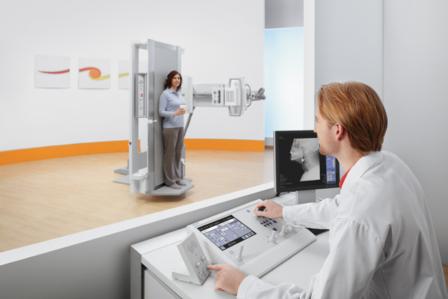
Luminos Fusion, according to the company is has two-in-one functionality, with flat panel detector technology allows more effective use of fluoroscopy equipment in routine medical care. The flat panel detector enables faster examinations and patient throughput compared to the mid-range image intensifiers that have been available up to now.
Luminos Fusion has a 43x43cm image surface to provide full-digital, distortion-free X-ray and fluoroscopic images.
The higher-quality images generated by the flat panel detector give radiologists better diagnostic information and provide images double the size of that of those achieved with typical image intensifiers, according to a company release, and the flat panel detector also takes up less space than image intensifiers and makes it easier for medical personnel to position the patient.
“Luminos Fusion brings Siemens’s flat panel detector technology to the mid-range price segment,” notes André Hartung, CEO of X-ray Products at Siemens Healthcare. “This means that even more customers and patients can benefit from faster examinations and higher diagnostic image quality.”
The flat panel detector in Luminos Fusion was until now, only available in a higher range price segment. The two-in-one technology is now available to an expanded customer base. Since fluoroscopy patients typically need to fast before an examination employing contrast agents, for example, appointments are advised to be scheduled in the morning. However, Luminos Fusion is available in the afternoon for X-ray imaging, so the equipment can be utilised at greater capacity. Luminos Fusion is equipped with SmartTouch technology for greater safety in the examination room.
To reduce the risk of unwanted movements, the joysticks require skin contact of the operator’s hand, so the system cannot be moved accidentally and injure patients or medical personnel. Luminos Fusion also features the Careposition functionality, which enables radiation-free positioning of the examination area to protect against unnecessary radiation. Graphics on the screen show the user the position of where a new image will be taken relative to the last image taken.










